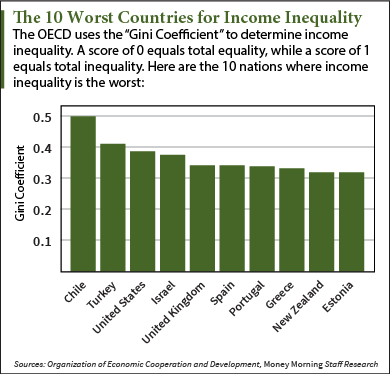The wealth gap in the United States and other developed countries hasn't been this big since the 1980s, according to a new report from the Organization of Economic Cooperation and Development (OECD).
The wealth gap is the unequal distribution of assets within a population. In the 1980s, the top 10% of earners in the developed world made seven times the income of the bottom 10%. But the wealth gap has expanded since. By 2013, the top 10% had 9.6 times the income of the bottom 10%. That was across 34 nations.
And the numbers in the United States are even worse.
In 2007, the wealth gap was 15.1 in the United States. By 2014, it had reached 18.8.
"In recent decades, as much as 40% of the population at the lower end of the distribution has benefited little from economic growth in many countries," the OECD report said. "In some cases, low earners have even seen their incomes fall in real terms. When such a large group in the population gains so little from economic growth, the social fabric frays and trust in institutions is weakened."
The OECD also uses a figure called the "Gini coefficient" to determine where income inequality is the worst. A score of 0 means complete equality, while a score of 1 means complete inequality. This chart shows the 10 worst nations in the world for income inequality.

According to the report, the wealth gap isn't just a problem for the bottom 10%. Income inequality can have a major long-term impact on a nation's economic growth.
"High and often growing inequality raises major economic concerns, not just for the low earners themselves but for the wider health and sustainability of our economies," it said. "Put simply: rising inequality is bad for long-term growth."
One of the way the OECD says the issue can be remedied is increased education and skills acquisition among the bottom 10% of earners. But of course, that's not an overnight fix.
According to Money Morning Capital Wave Strategist Shah Gilani, one of the biggest causes for the massive wealth gap in the United States is the Federal Reserve's Quantitative Easing program. The program has been ruinous for the economy, the bond market, and the stock market.
But there's a way you can turn this "disruption" in your favor - and even profit from it...continue reading here to find out how...
Follow me on Twitter @KyleAndersonMM.
Related Articles:
- MarketWatch: Wealth Gap Is at Its Widest Since the '80s: OECD


